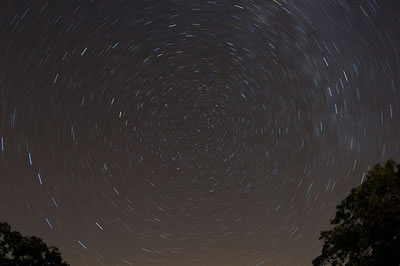Circumpolar stars as seen near Sisseton, SD. Big Dipper is in lower left.
Click on image for full size
Public domain/Wikipedia
Northern Circumpolar Constellations
Because of the rotation of the Earth and its orbit around the Sun, we divide the stars and constellations into two groups. Some stars and constellations never rise nor set, and they are called circumpolar. All the rest are divided into seasonal stars and constellations. Which stars and constellations will be circumpolar and which seasonal depends on your latitude. In the northern hemisphere, we will always be able to see stars and constellations in the the northern circumpolar sky, while in the southern hemisphere, we will always be able to see stars and constellations in the southern circumpolar sky.
Constellations in the northern circumpolar sky include Auriga, Camelopardalis, Cassiopeia, Cepheus, Draco, Lynx, Perseus, Ursa Major, and Ursa Minor. These constellations are always visible in the night sky of the Northern Hemisphere.
Constellations in the southern circumpolar sky include Grus, Phoenix, Indus, Tucana, Pavo, Ara, Eridanus, Hydrus, Horologium, Reticulum, Octans, Apus, Triangulum Australe, Lupus, Circinus, Musca, Crux, Centaurus, Carina, Vela, Puppis, Dorado, and Chamaeleon. These constellations are always visible in the night sky of the Southern Hemisphere.
You might also be interested in:
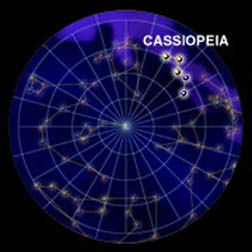
Cassiopeia was the wife of King Cepheus. She was very pretty, and would often brag that she and her daughter were more beautiful than the sea nymphs, the Nereids. They complained to Poseidon, who sent
...more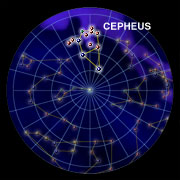
Cepheus was king of a land called Ethiopia in Greek myth. He had a wife named Cassiopeia and a daughter, Andromeda. Cassiopeia liked to brag about her beauty so much, that she said she and Andromeda were
...more
Draco the dragon is a circumpolar constellation, which means it revolves around the North pole. It can be seen all year round. Draco is only present in the Northern Hemisphere, so those living in the
...more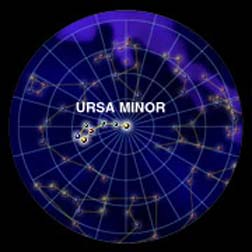
Ursa Minor, also called the Little Dipper, is a circumpolar constellation. This means it never sets in the northern sky. The true figure represented by the stars is the Little Bear. Its counterpart is
...more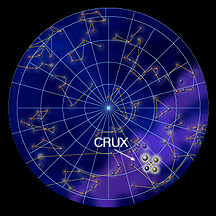
If you live in the Northern Hemisphere, you must be south of latitude 30 degrees to begin observing Crux, one of the smallest, but most easily recognized constellations in the sky. Crux lies along the
...more
Below the stars of Hydra, the sea serpent, and Scorpius, the scorpion, you can find the half-man, half-horse creature, Centaurus. He faces east holding a lance-like pole which he is using to kill Lupus,
...more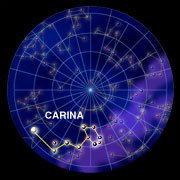
The constellation Carina is known as the Keel, which is the bottom part of old ships. Carina was originally a part of Argo Navis, which was a huge boat in the night sky. It has since been divided into
...more
Constellations are formed of bright stars which appear close to each other on the sky, but are really far apart in space. The shapes you see all depend on your point of view. Many societies saw patterns
...more


